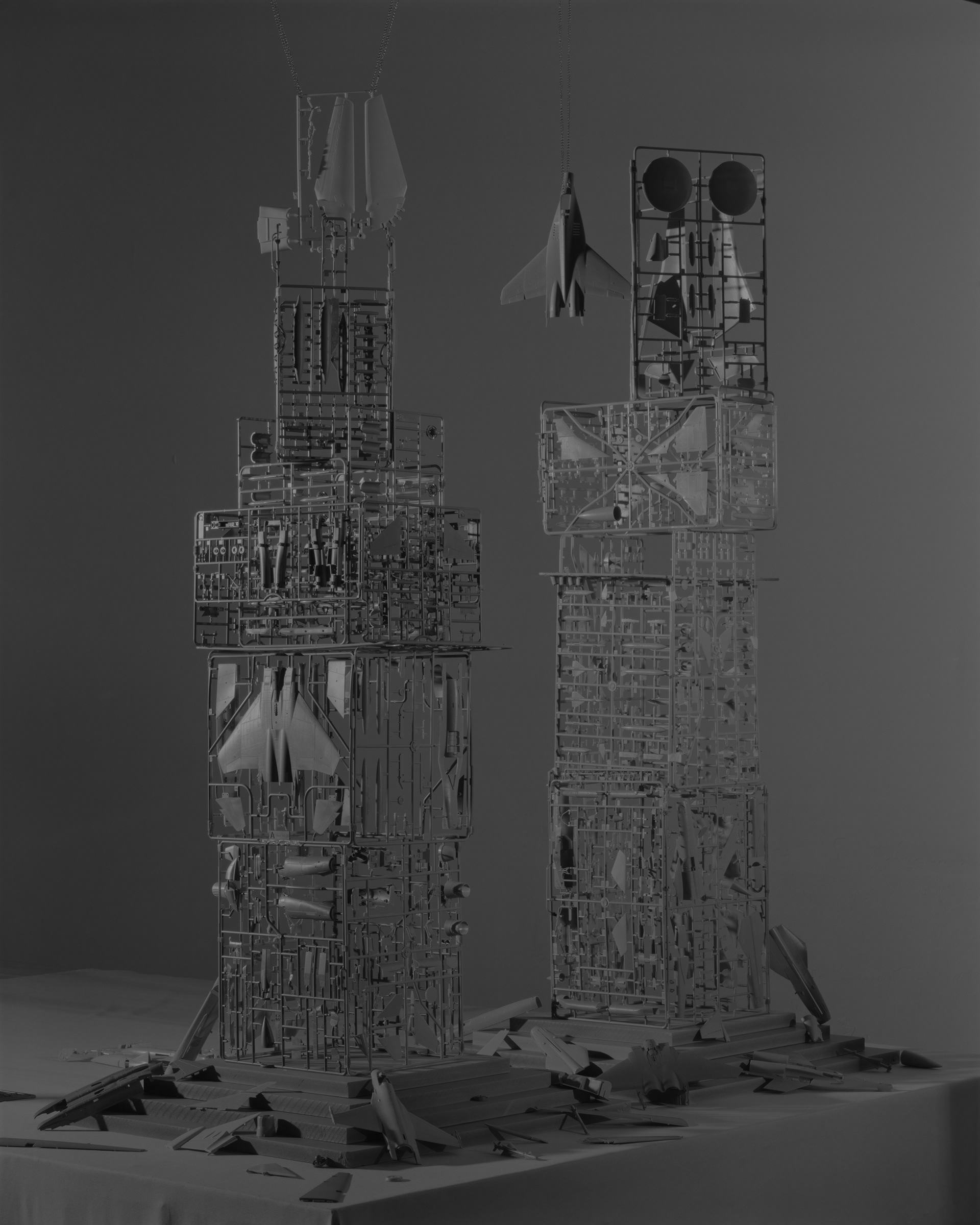

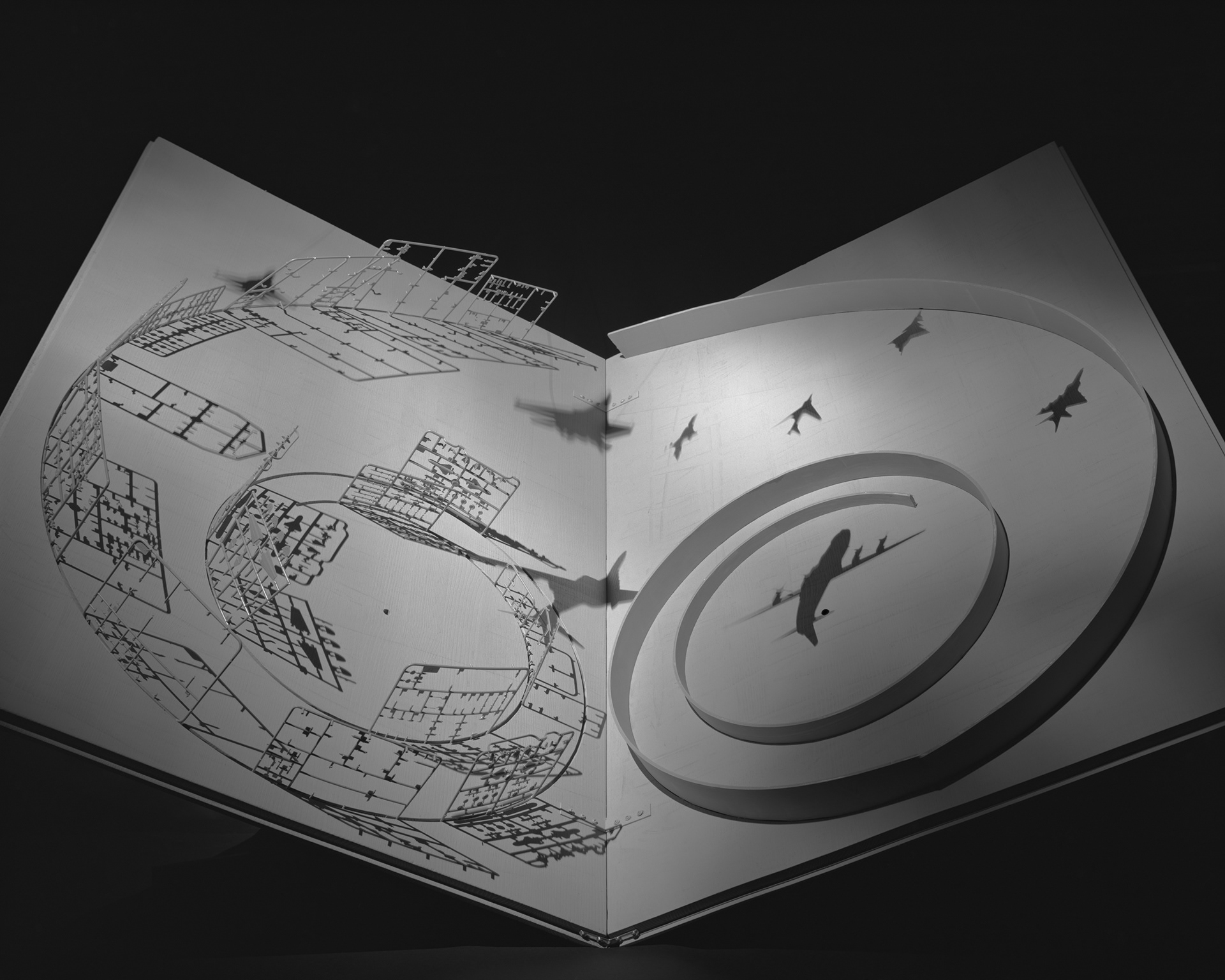
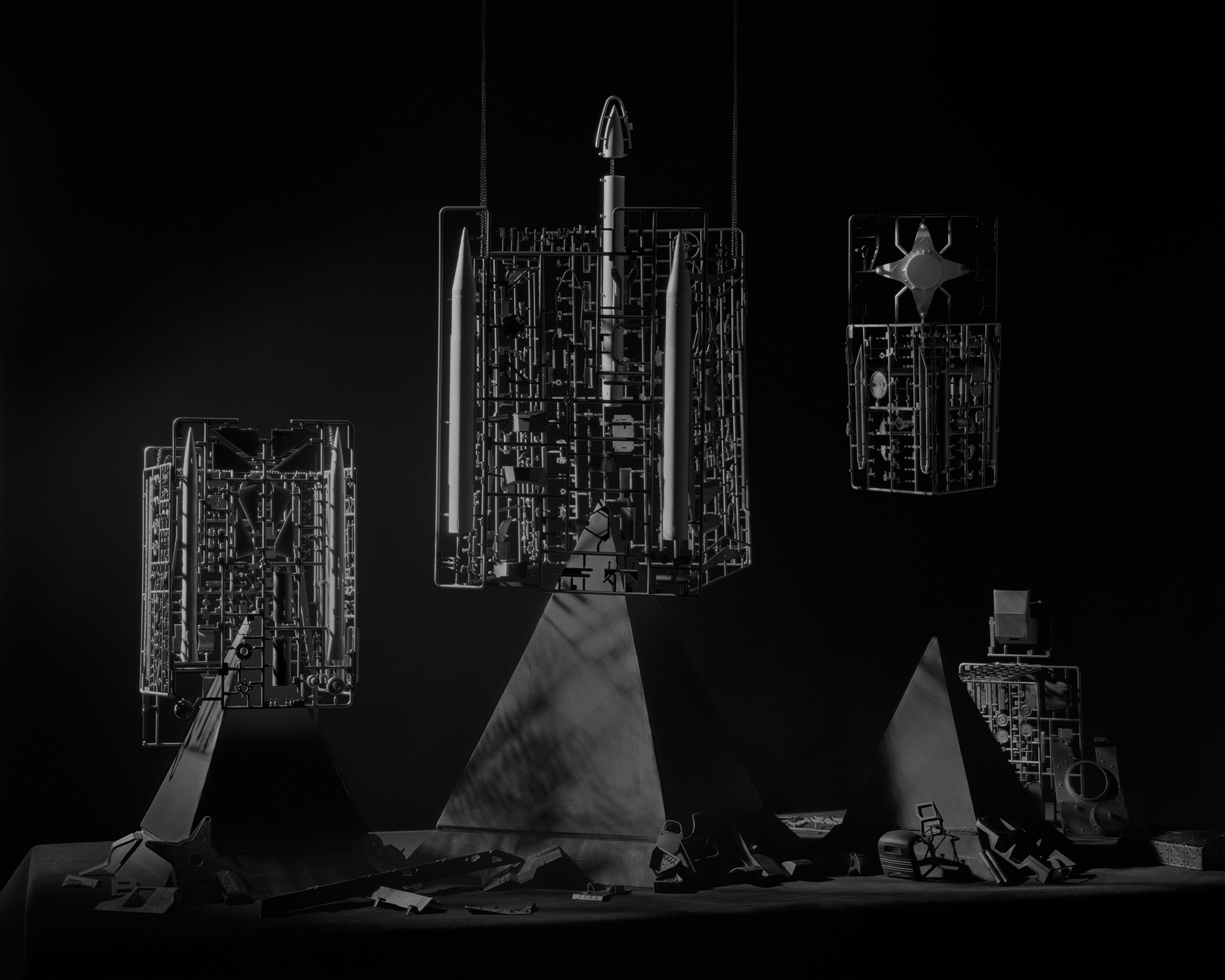
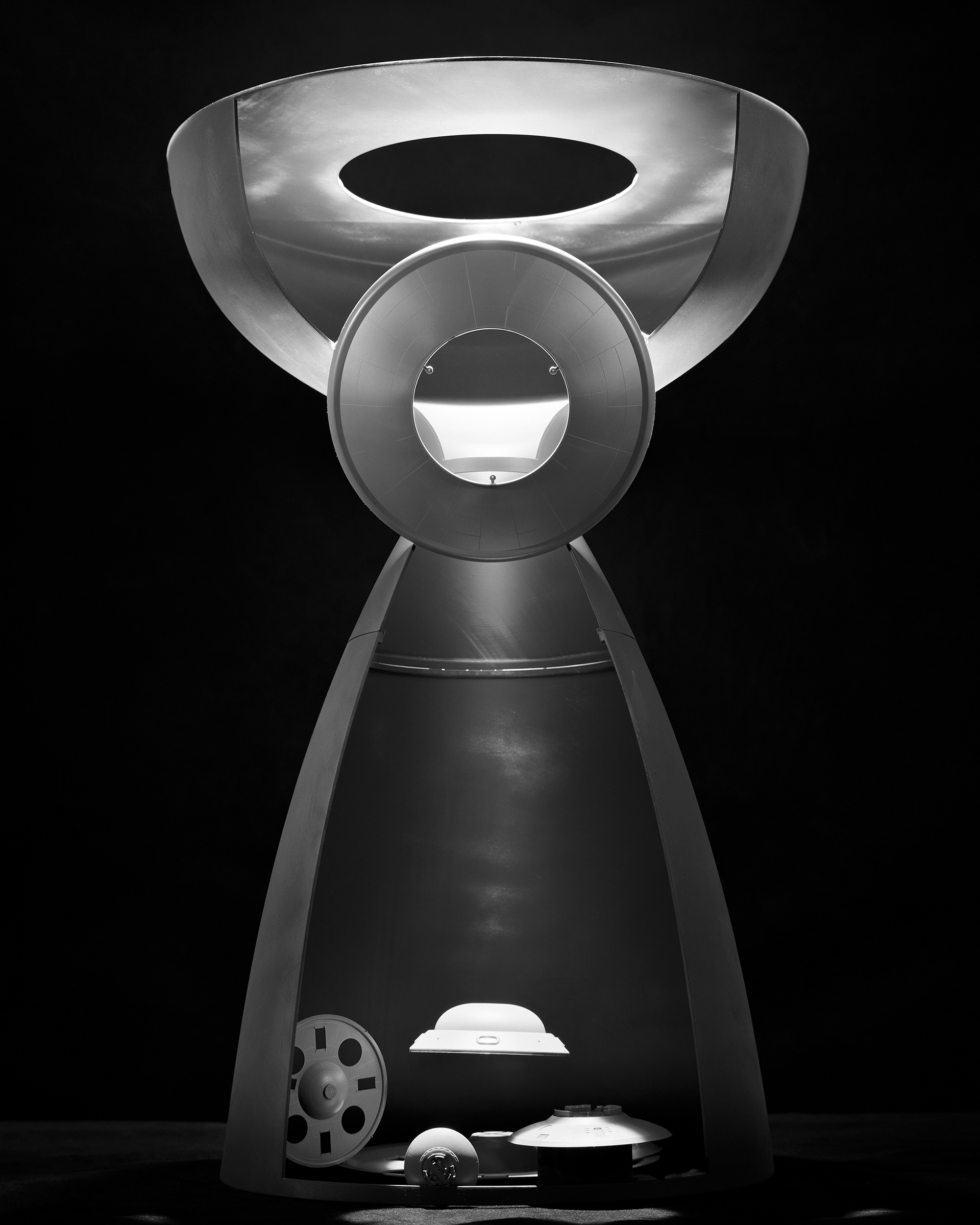
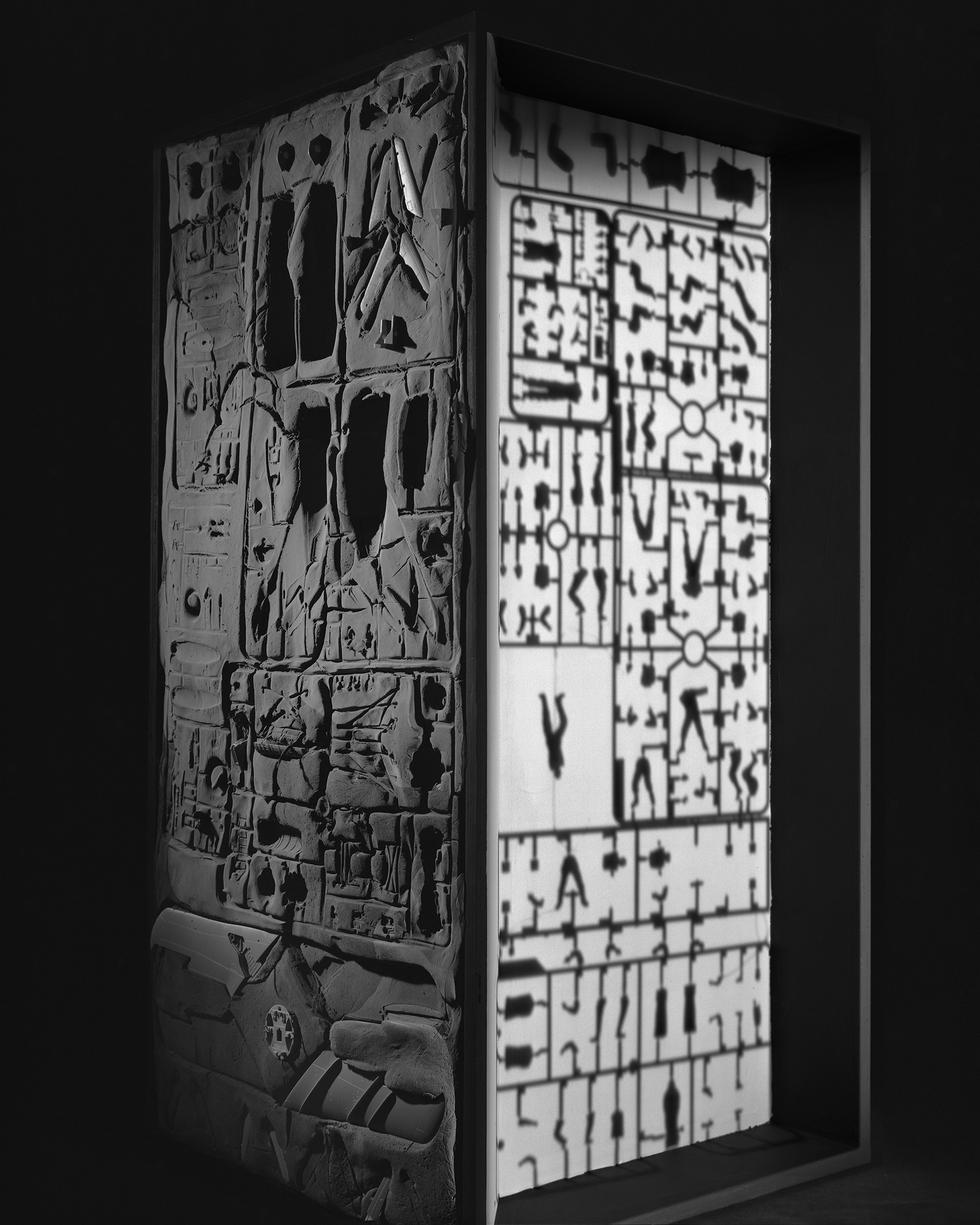
These photographs showcase a couple of stories from 1990s to 2000s. At one time plastic model kits were my favorite hobby. I built makeshift sculptures using unassembled model kit boards combined with some basic materials, photographed them with an 8X10 large format camera, and dismantled the sculptures when I was done.
From Left to Right:
Karafuto
"Karafuto" is the first of this series. I have built two crumbling "Twin Towers" using model kits of the main US and Soviet aircraft of the Cold War. One of them is full of American airplanes and the other one is full of Soviet airplanes. These models came from a doubtful story I read 20 years ago in a military magazine. The story was about the air disaster of Korean Air Flight 007 in the early morning hours of September 1, 1983, when Korean Air Flight 007 entered Soviet airspace, was attacked by a Soviet Air Force Su-15 interceptor, and crashed in the open sea southwest of the Karafuto. A fierce air battle between American and Soviet warplanes ensued over the Karafuto, with dozens of fighters deployed and losses exchanged, and the incident has been described in this report with great fanfare as the only hot war in direct contact between the United States and the Soviet Union in the history of the Cold War. In order to argue the authenticity of the incident, the report also took the Soviet Union at the time of the latest model fighter MiG 29 as an argument "in 1986, the aircraft visited Finland, although it was the first time in the world in front of the exposure, but the U.S. pilots present at the meeting with old friends.” I have since checked the veracity of this report from various sources at home and abroad, but have found no evidence of this air battle.
Bunker
The Bunker here refers to the dozens of large and small airplane shelters built by the Japanese invading forces in Beijing near the present Nanyuan Airport during the Anti-Japanese War. These aircraft bunkers are shaped like an inverted pot. Their purpose was to provide cover for Japanese planes and prevent bombing by the Allies Air Forces. I grew up living near these bunkers, but I didn't know the purpose of these strange structures, and I often climbed to the top of these "big pots" after school and stayed there until it was almost dark. I asked my parents, teachers, classmates, and people in the neighborhood, but none of them knew what these buildings were for. Some said they were warehouses, some said they were oil depots, and some said they were air raid shelters built after the conflict with the Soviet Union. Later, some of the "pot" were demolished, while others were encircled with walls and used as factories, and gradually disappeared from view. It was only in the last few years that the remaining buildings were protected with monuments for cultural relics protection, and thus I learned that they were airplane shelters. I found less than 10 of them through satellite maps, measured their sizes and guessed what types of planes might have been parked back then. The plastic models of these airplanes were arranged in the relative positions of the bunkers to construct the view of this work.
Horn
The third piece is called "Horn". It comes from some sound-related conversations I had with my father when I was a child. Since my apartment was located near the airfield of the Air Force, military planes carrying out air force missions in the capital city basically took off from my apartment, such as military parades. My dad's hearing was so good that he could tell the type of airplane by the sound of its engine. So whenever there was an airplane overhead, my dad would tell me whether it was a civilian or military airplane, and whether it was a single-engine or twin-engine airplane. (My dad was an audiophile, and he used to listen to music at home on his own hand-built stereo.) At that time, my mind wasn't on these things, so I just agreed with him. Later when I was studying in the U.S., I heard U.S. military airplanes flying overhead for the first time in the southernmost part of Miami near Cuba. It suddenly struck me that it did sound very different from what I had heard as a child, and I realized that I could also roughly tell the difference between the engine sounds of military aircraft. I borrowed few parts of a horn speaker my dad had made, disassembled it, and left the "Nautilus" cut side out. Then I hung some models of our military airplanes that my dad had taught me to recognize when I was a kid, and let their shadows cast on the horn speaker panel.
Abu Dhabi
I used to own a pile of export catalogs of military weapons, all found in junkyards, illustrated in exotic Arabic styles and with descriptions in English and Arabic. Adults told me they were promotional materials for International defense exhibitions. These found catalogs became "picture books" that I used to flip through at home alone, cutting out and re-collaging photos of different pieces of military weapons. One of my favorites was a huge cross-page illustration of several missile launchers, with a large desert at night in the background. All of these missile launchers were in launch mode, shooting missiles in strange forms around the illustration. My feeling for this illustration had a resonance with Elton John's Rocket Man. The illustration was carefully collected, but eventually it was lost after a couple of moves, and the images faded from memory as time goes on. Recently, when I saw Christopher Nolan’s Oppenheimer, in the scene which Borden as a World War II pilot, sees the German V2 rockets slowly overtaking his plane in the night, the illustration was suddenly reawakened from my memory. I found some models of missile launchers that fit the time period and reconstructed them. It is similar in content to the old memorized illustration, but uses a new style that is in line with my current state of mind.
No Dreams in Space
When China's first Long March 3B rocket launched the Intelsat 708 satellite on February 15, 1996, it flew sideways due to the failure of the newly replaced platform, resulting in the destruction of the rocket and the satellite and the injury and death of many people at the base. This incident nearly changed my life. I saw this incident on the news, and my mom said she had a close colleague who passed away in the accident, and that she was supposed to be at the launch site, but her colleague wanted to get a promotion, so she gave the opportunity to this colleague, and as a result, this colleague of hers became one of the victims of the accident. Since then, my mother has never placed a high priority on her work, but rather on our family. She told us that her colleague was not on duty at that time, but was resting alone in a room, and when the rocket exploded, it shattered the glass of the building, and a piece of glass pierced into the colleague's blood vessel, and due to the power outage after the accident, the rescuers didn't know that there was a person in the area at all, and the colleague eventually died of excessive blood loss. This incident did not leave a deep impression on me at the time. It wasn't until later when I saw the documentary "No Dreams in Space" on the internet that I was shocked by the tragic scene of the accident. This work is a combination of my childhood dream of exploring space and the thoughts about death caused by the astronautical accident.
Wind Tunnel
In the late 90's, part of the airfield next to my apartment was open to the neighborhood. In the summer, my mom used to take me there to climb on airplanes and play with the kids. In the open space next to the military airfield, there were several retired Jian-5s with their engines removed, leaving only the hollow intake tunnels and tail jets. My buddies and I loved to crawl through the air intakes and hide and seek inside the airplanes. The air intake of Jian-5 was in the nose of the airplane, the whole nose was a huge cavity, it was very easy to climb in, after a certain distance, the air intake ducts would be separated from left to right, and if you chose one side to continue to climb in, it would get narrower and narrower, and finally it would get stuck. One of my friends, who was very skinny, was able to climb all the way up one side of the intake to a depth where he couldn't even see him from the entrance. I tried and failed many times, and the claustrophobia of being crammed into a cramped, dark metal space was too much for me to handle. The structure of the deepest part of the air intake duct was one of the top few unsolved mysteries of my childhood. I put unassembled model soldiers with separated limbs and a diaglyph board of that Jian-5 model in two intake-like symmetrical boxes to recreate the memories and imagery of limbs facing bifurcation, snagging and crushing in an unknown passageway.